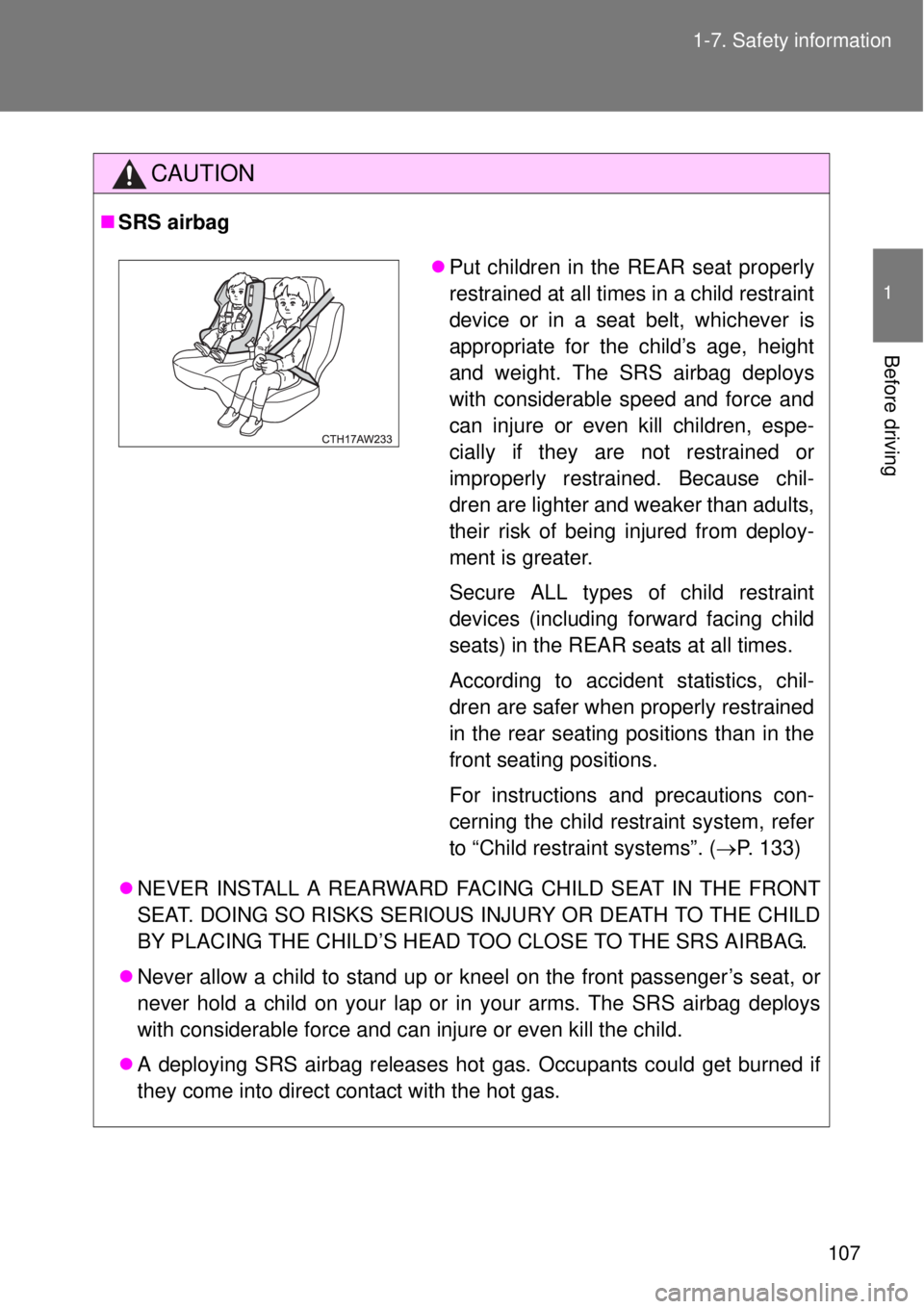Page 107 of 464

107 1-7. Safety information
1
Before driving
CAUTION
SRS airbag
NEVER INSTALL A REARWARD FACING CHILD SEAT IN THE FRONT
SEAT. DOING SO RISKS SERIOUS INJURY OR DEATH TO THE CHILD
BY PLACING THE CHILD’S HEAD TOO CLOSE TO THE SRS AIRBAG.
Never allow a child to stand up or kneel on the front passenger’s seat, or
never hold a child on your lap or in your arms. The SRS airbag deploys
with considerable force and can injure or even kill the child.
A deploying SRS airbag releases hot gas. Occupants could get burned if
they come into direct contact with the hot gas.
Put children in the REAR seat properly
restrained at all times in a child restraint
device or in a seat belt, whichever is
appropriate for the child’s age, height
and weight. The SRS airbag deploys
with considerable speed and force and
can injure or even kill children, espe-
cially if they are not restrained or
improperly restrained. Because chil-
dren are lighter and weaker than adults,
their risk of being injured from deploy-
ment is greater.
Secure ALL types of child restraint
devices (including forward facing child
seats) in the REAR seats at all times.
According to accident statistics, chil-
dren are safer when properly restrained
in the rear seating positions than in the
front seating positions.
For instructions and precautions con-
cerning the child restraint system, refer
to “Child restraint systems”. (P. 133)
Page 111 of 464

111 1-7. Safety information
1
Before driving
SRS front airbag
The driver’s SRS front airbag is stowed in the center portion of the steering
wheel. The driver’s knee airbag is stowed under the steering column. The
passenger’s SRS front airbag is stowed near the top of the dashboard under
an “SRS AIRBAG” mark.
In a moderate to severe front collision, the following components deploy.
SRS front airbag for driver
SRS front airbag for front passenger
Knee airbag for driver
These components supplement the seat belts by reducing the impact to the
occupant’s head, chest and knees.
If the SRS airbags deploy (inflate)
Bruising and slight abrasions may result from contact with a deploying
(inflating) SRS airbag.
A loud noise and white powder will be emitted.
Parts of the airbag module (steering wheel hub, airbag cover and inflator)
as well as the front seats, parts of the front and rear pillars, and roof side
rails, may be hot for several minutes. The airbag itself may also be hot.
The windshield may crack.
Front-seat passenger airbag manual cut off switch
The passenger-side front airbag can be deactivated by the cut off switch
located in the instrumental panel side. When the cut off switch is turned to
the deactivation mode the passenger-side front airbag becomes deacti-
vated. When the cutoff switch is turned to the activation mode the passen-
ger-side front airbag becomes active to deploy. While the passenger-side
front airbag is active the A/B ON indicator is illuminated.
Page 112 of 464
112 1-7. Safety information
Normal operation
When the system is malfunctioning
ONOFF
Front airbag for front passenger Activated Deactivated
Seat belt pretensioner for front pas-
senger
Activated Activated Side air bag for front passenger
Curtain shield air bag for front pas-
senger
SRS warning light Not illuminated Not illuminated
Airbag manual on-off indicator “ON” Illuminated Not illuminated
Airbag manual on-off indicator
“OFF”Not illuminated IlluminatedAirbag manual on-off
switch
Airbag system
Airbag systemOperation
Front airbag for front passenger Deactivated
Seat belt pretensioner for front pas-
senger
Activated Side air bag for front passenger
Curtain shield air bag for front pas-
senger
SRS warning light Illuminated
Airbag manual on-off indicator “ON” Not illuminated
Airbag manual on-off indicator
“OFF”Illuminated
Page 126 of 464

126 1-7. Safety information
CAUTION
SRS airbag precautions
• Slightly recline the back of the seat. Although vehicle designs vary,
many drivers can achieve the 250 mm (10 in.) distance, even with the
driver seat all the way forward, simply by reclining the back of the seat
somewhat. If reclining the back of your seat makes it hard to see the
road, raise yourself by using a firm, non-slippery cushion, or raise the
seat if your vehicle has that feature.
• If your steering wheel is adjustable, tilt it downward. This points the air-
bag toward your chest instead of your head and neck.
The seat should be adjusted as recommended above, while still maintain-
ing control of the foot pedals, steering wheel, and your view of the instru-
ment panel controls.
The SRS front passenger airbag also deploys with considerable force, and
can cause death or serious injury especially if the front passenger is very
close to the airbag. The front passenger seat should be as far from the air-
bag as possible with the seatback adjusted, so the front passenger sits
upright.
Improperly seated and/or restrained infants and children can be killed or
seriously injured by a deploying airbag. An infant or child who is too small
to use a seat belt should be properly secured using a child restraint sys-
tem. Toyota strongly recommends that all infants and children be placed in
the rear seats of the vehicle and properly restrained. The rear seats are
safer for infants and children than the front passenger seat. (P. 133)
Do not sit on the edge of the seat or
lean against the dashboard.
Page 130 of 464
130 1-7. Safety information
SRS airbag system monitor
SRS warning light
A diagnostic system continually
monitors the readiness of the
SRS airbag system (including
front seat belt pretensioners)
while the vehicle is being driven.
The SRS warning light will show
normal system operation by illu-
minating for approximately 6
seconds when the engine switch
is turned to the “ON” position
(vehicles without a smart entry &
start system), or the “ENGINE
START STOP” switch is turned
to IGNITION ON mode (vehicles
with a smart entry & start sys-
tem).
The following components are monitored by the indicator.
Front sub sensor
• Right-hand side
• Left-hand side
Airbag control module (including impact sensor)
Front airbag module
• Driver’s side
• Front passenger’s side
Knee airbag module (driver’s side)
Page 132 of 464

132 1-7. Safety information
CAUTION
SRS warning light
If the warning light exhibits any of the following conditions, there may be a
malfunction in the seat belt pretensioners and/or SRS airbag system. We
recommend that you have the system checked immediately by your nearest
any authorized Toyota dealer or repairer, or another duly qualified and
equipped professional. Unless checked and properly repaired, the seat belt
pretensioners and/or SRS airbags will operate improperly (e.g. SRS airbags
may inflate in a very minor collision or not inflate in a severe collision), which
may increase the risk of injury.
Flashing or flickering of the warning light
No illumination of the warning light when the engine switch is first turned to
the “ON” position (vehicles without a smart entry & start system), or the
“ENGINE START STOP” switch is turned to IGNITION ON mode (vehicles
with a smart entry & start system).
Continuous illumination of the warning light
Illumination of the warning light while driving
Page 151 of 464
151
1
1-7. Safety information
Before driving
Airbag manual on-off system
This system deactivates the front passenger airbag.
Only deactivate the airbags when using a child restraint system on
the front passenger seat.
Airbag manual on-off indica-
tor
Vehicles without a smart
entry & start system
This indicator light turns on
when the airbag system is on
(only when the engine switch is
in the “ON” position).
Vehicles with a smart entry &
start system
This indicator light turns on
when the airbag system is on
(only when the “ENGINE
START STOP” switch is in
IGNITION ON mode).
Airbag manual on-off switch
Page 152 of 464
152 1-7. Safety information
Deactivating the front passenger airbag
Vehicles without a smart entry
& start system
Insert the key into the cylinder
and turn to the “OFF” position.
The “OFF” indicator light turns on
(only when the engine switch is in
the “ON” position).
Vehicles with a smart entry &
start system
Insert the mechanical key into
the cylinder and rotate to the
“OFF” position.
The “OFF” indicator light turns on
(only when the “ENGINE START
STOP” switch is in IGNITION ON
mode).